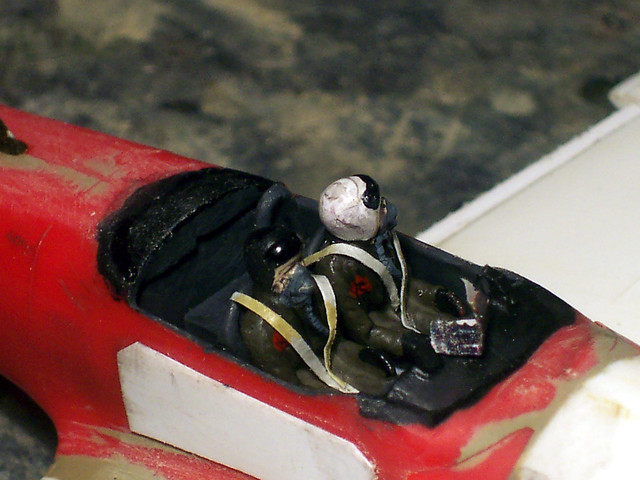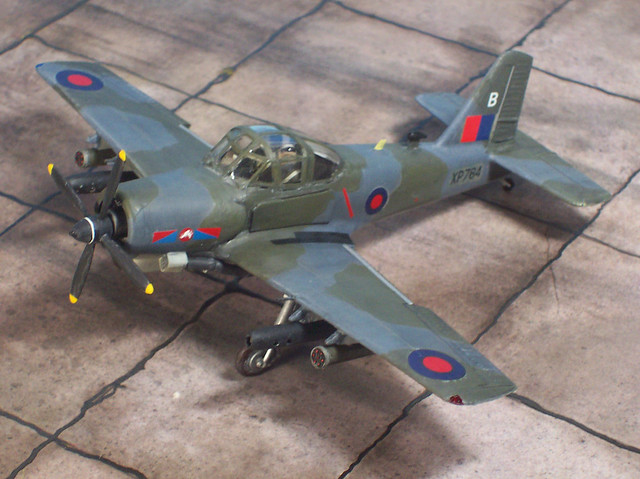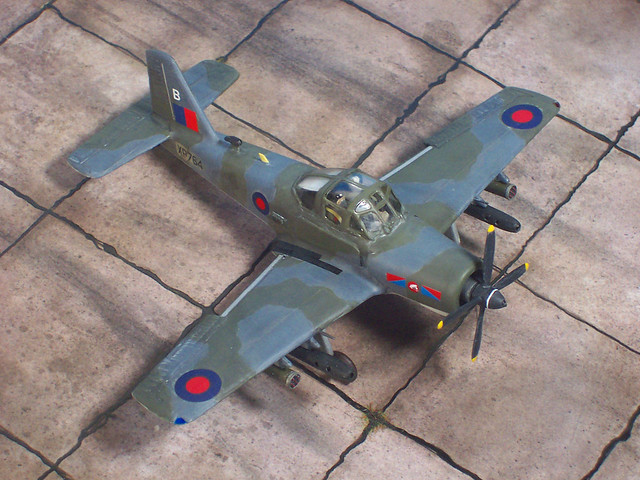Was Obskures - die Provost wird kaum jemand kennen, und vermutlich noch weniger die Historie der 1417 Flight der RAF, die lange Jahre im mittelamerikanischen Belize stationiert war und das Empire verteidigt hat. Aber in dieses "Loch" fällt dieser Umbau...
 Some background:The Percival P.56 Provost was a British ab initio trainer that was developed for the Royal Air Force in the 1950s as a replacement for the Percival Prentice. It was a low-wing, monoplane with a fixed, tailwheel undercarriage and had an unusual side-by-side seating arrangement. The Provost has the distinction of being the last piston-engine basic trainer aircraft to be operated by the RAF.
Some background:The Percival P.56 Provost was a British ab initio trainer that was developed for the Royal Air Force in the 1950s as a replacement for the Percival Prentice. It was a low-wing, monoplane with a fixed, tailwheel undercarriage and had an unusual side-by-side seating arrangement. The Provost has the distinction of being the last piston-engine basic trainer aircraft to be operated by the RAF.
The Provost entered service with the RAF in 1953 with the first batch of aircraft delivered to the Central Flying School (CFS) at RAF South Cerney. The CFS carried out intensive flight trials in May and June 1953 before instructor training commenced. The aircraft served with the RAF until the early 1960s, when it was replaced by the Jet Provost. A few Provosts continued in service during the 1960s with the Central Navigation & Control School (later Central Air Traffic Control School) at RAF Shawbury. But that was not the end of the Provost in RAF service.
Even though phazed out from active service, ten Provost were reactivated in 1971 for an observation and forward air control (FAC) aircraft - the Provost, with its simple handling, high endurance ans spacious cockpit was more than worth a look.
In the wake of modernization the Provost GR.2, how the type was officially called, received much of the armed Mk. 52 and 53 export machines' equipment, including the wing-mounted machine guns and an improved radio and navigation suite. The aircraft also received four underwing hardpoints for various light loeads, including pods with unguided missiles for target marking, light iron bombs or gun pods. In order to compensate for the higher gross weight an uprated Alvis Leonides 127 9-cylinder radial engine, rated at 700 hp (515 kW), was mounted, together with a four-bladed propeller that would increase overall length by some inches and improve starting characteristics and handling at low speed.

The machines were taken through army trials in 1973 and 1974, but they eventually failed against helicopters as the more flexible option for front line service. However, the Provost GR.2 was not dead yet!
In 1975, with Guatemala in the grip of a bloody civil war, there was a real fear that Guatemalan forces might invade British Honduras (today known as Belize) and at the very least widen their Caribbean coastline. To bolster the resident British Army garrison, a detachment of six Hawker Siddeley Harrier GR.1As from No. 1 Squadron RAF was sent to the international airport at Ladyville in November 1975. There they set about waving the flag and discouraging Guatemalan aggression. After several months the threat was perceived to have subsided and the Harriers returned to the UK in April 1976 - and in turn a detachment of six Provost GR.2s was sent into the Caribbean theatre in order to keep up British military presence.
This did not help much, though, since the Harriers had to return on a more permanent basis in June 1977, as part of a complete package, of the Queen's Regiment of the British Army, in a Vickers VC10 C1 and six Harriers from No 1 (Fighter) Squadron flying direct with support from ten Handley Page Victor tankers.

Thus was born HarDet Belize; the six Harriers were operated from semi-permanent hides, named using the NATO phonetic alphabet. Alpha and Bravo hides were set up in the grounds of the Belikin brewery outside the gates to the garrison, while the Provosts were kept at the international airport, called the Echo hide.
After operating as a rotating roulement for two years, the Hardet was put on an even more permanent footing. In the meantime, the Provost observation machines had been upgraded with external kevlar armor plates around the cockpit, an up-to-date radio equipment and other small improvements like a sound damper for the exhaust, a strengthened landing gear with bigger wheels for field operations and an enhanced air conditioning system which became a must in the tropic climate. All machines were brought to this standard and called Provost GR.2A by late 1978.

Much flying was done, with plenty of flag-waving and sabre-rattling, the aircrew enjoying the post due to the lack of restrictions, and challenging missions. Eventually operations were confined to Charlie/Delta and Foxy/Golf hides for the Harriers which went through a slow metamorphosis to permanent semi-hardened hides with concrete surfaces and taxi-ways and block built buildings (including accommodation, kitchen and bars). The Provosts were finally retired in 1988, but the RAF's Belize engagement went on until closure on 6 July 1993, when the whole BRITFORBEL contingent was disbanded in the light of improved relations between Guatemala and Belize.
General characteristics: Crew: 2
Length: 29 ft 2 in (8,89 m)
Wingspan: 35 ft 0 in (10,7 m)
Height: 12 ft 0 in (3,70 m)
Wing area: 214 ft² (19,9 m²)
Empty weight: 3.580 lb (1.625 kg)
Loaded weight: 4.912 lb (2.230 kg)
Powerplant: 1× Alvis Leonides 127 9-cylinder radial engine, 700 hp (515 kW)
Performance: Maximum speed: 220 mph (187 knots, 350 km/h) at sea level
Range: 560 nm (650 mi, 1,020 km)
Endurance: 4 hours
Service ceiling: 25,000 ft (7620 m)
Rate of climb: 2,200 ft/min (11.2 m/s)
Wing loading: 20.6 lb/ft² (100 kg/m²)
Power/mass: 0.276 hp/lb (0.206 kW/kg)
Climb to 10,000 ft 3.27 minutes
Armament: 2x 7.62mm machine guns in the wings,
plus four underwing hardpoints for up to 900 kg (2.000 lbs.) of bombs or rockets
Zum Bausatz:Die Idee hierzu spukte schon lange im Hinterkopf herum, aber an einen günstigen Bausatz zu kommen war knifflig - immerhin gibt es nur den von Matchbox, und der war nie populär. Oder Resin bzw. Vacu-Kits, aber beides nicht so meins (zu teuer, zu kompliziert).
Es sollte eine aufgerüstete, bewaffnete Version des Trainers, werden, mit einem Schritt mehr als die bewaffneten Exportversionen die z. B. an den Oman oder Rhodesien gegangen waren.
Die GR.2A ist daher prinzipiell OOB gebaut, aber... Im Cockpit gab es ein Armaturenbrett und Sicherheitsgurte fürs Personal, einen Sonnenschutz in der Heckscheibe, eine Karte auf dem Armaturenbrett, der Copilot guckt aus dem Fenster.



Die Räder sind neu (Matchbox Brewster Buffalo), die Pylone sind von zwei Matchbox AH-1Gs. Der Propeller ist auch neu, von einer 1:100 An-24 vom VEB Plasticart aus der Ex-Täterä.
Die Panzerplatten sind einfaches Plastik-Sheet, dazu auch einige Antennen. Der Auspuss ist auch neu, so besteht das Rohr aus einem verbogenen ACMI-Pod...

.
Die M134 pods kommen auch von einer Matchbox AH-1G, die LAU-7 Pods von einer Italeri AH-64.
Die Bemalung ist konservativ in RAF-Farben der Zeit, Extra Dark Slate Grey & Extra Dark Sea Grey oben, Light Aircraft Grey unten, alles Humbrol (163, 164 + 166), dazu leichtes Weathering mit helleren Tönen, vor allem beim Grau. Auf einigen Bildern sehen Harrier des 1417 Flight in Belize fast hellblau aus!
Die Decals sind zusammengepuzzelt - "XP764" gehört an sich zu einer RAF BAC Lightning, das Emblem des 1417 Flight (ein Schwertfisch auf Rot und Blau) ist komplett improvisiert.



Ein kleines, einfaches Projekt vom Ende letzten Jahres - war aber nicht das letzte!
